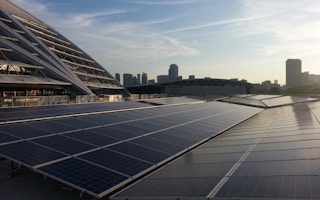The global solar industry has in the past decade enjoyed rapid growth, with total installed capacity growing more than 200 times from 806 megawatts in 2000 to about 175 gigawatts last year, according to the International Renewable Energy Agency (IRENA).
Sunny Singapore has seen a similar trend. The city-state’s Energy Market Authority says that the total capacity of solar PV systems doubled from 2013 to 2014, from about 14 megawatts peak (MWp) at the end of 2013 to 30.8MWp at the end of last year.
This figure is set to multiply thanks to a government target to install 350MWp of solar energy on public sector rooftops by 2020.
Solar energy is becoming increasingly attractive, especially as it is now at grid parity in Singapore - that is, the cost of generating solar energy is competitive with the cost of fossil fuel-derived electricity provided by the national utility, even without subsidies.
But despite solar’s growing popularity, commercial and residential clients may not always have all the right information to ensure that their solar systems are long-lasting and high-performing.
Andre Nobre, head of PV systems technology group at the Solar Energy Research Institute of Singapore (SERIS), adds that if a solar PV installation is not done right, problems such as low energy yields, frequent system failure, and faulty components can create a negative perception of solar, which could affect growth numbers for PV in Singapore.
From the experience and expertise of the installer to the location and exact angle at which the panels sit, the variables that affect how a solar system will perform for a client are numerous and complex.
Here are five pointers from solar experts on how clients can achieve the perfect solar installation.
1. Choose a reliable integrator
PV systems integrators deliver many services to clients, including designing, building, and connecting a system to the grid. Setting up an installation in the ideal location, sourcing the best quality components, making sure it is safe, and that it delivers a good energy yield are all part of an integrator’s job.
Tai Xiang, senior vice president for Singapore’s largest PV installer Phoenix Solar, says that given the huge difference in quality that exists among installers, “it is our job to educate the client” on the difference and what responsible installers do to deliver the best possible system.
For example, before purchasing components from a new supplier, Phoenix Solar visits their factories and assesses their compliance with international certification standards and financial performance to ensure that the manufacturer does not compromise on quality to cut costs and that good working conditions are available for its workers, says Tai.
Clients should expect potential integrators to do the same, and should always ask for references and testimonials for the same type of installation they plan to purchase, says SERIS’s Nobre.
“Although I might be shown only “cherry-picked” excellent systems, at least I would have the peace of mind that such an integrator has successfully demonstrated having installed these systems before,” he explains.
In Singapore, the National Solar Repository is a valuable resource for solar buyers, adds Tai. The website tracks the efficiency and output of systems across the island, and has comprehensive explanations about the technical components of a system. While it is not mandatory for companies to publicise performance data, Phoenix Solar does so, says Tai. “Most integrators with high-performing systems would do the same”, she says.
2. The perfect installation starts with the perfect building
Getting the design right from the start can also reduce the upfront cost of a solar project, says Kong Wei Jie, sales manager of Phoenix Solar.
For example, metal roofs are better suited to solar installations than tiled roofs because they are easier to drill or attach clamps on. Therefore, if a building or home owner has already decided to install solar panels before construction begins, they should opt for a metal roof, he recommends.
He adds that it is important to take note of areas of the roof which are obstructed by surrounding buildings or trees. This is where 3D modelling can help: It can chart how the sun will shine on the roof over the course of the day and predicts energy output from a solar system,
“Selling a bigger system to clients means higher profits, but there is no point in installing panels on an area of the roof that is in shade most of the time,” he shares. Clients should ask to see 3D models and simulations before deciding on a system size, Kong suggests.
3. Get the angle right
Another often-overlooked aspect of a solar installation is the angle at which solar panels rest on the roof, says Nobre. Commercial and residential clients alike must make sure that PV modules are tilted to approximately 10 degrees, so that the panels can effectively ‘self-clean’ when it rains.
If the angle is not steep enough, rainwater collects on the panels and will lead to system degradation over time. “Although you hear integrators saying they follow this rule, the average tilt angle of systems is still six to seven degrees across the island,” he notes.
The National Solar Repository also lists the tilt angles of each installation, and clients can check to ensure that the company they choose sticks to the recommended tilt angle.
4. Compare your system with others
It is common for a company to promise a certain yield to potential new clients, but they may not always explain how this yield may be affected by factors such as the availability of sunlight or the quality of modules, says Nobre. This may lead to lower-than-expected energy yields.
Kong adds that customers should familiarise themselves with the solar system performance benchmark published on the National Solar Repository. This is a figure which indicates the minimum levels an installation should perform at. This currently stands at 1.08 megawatt hours per kilowatts peak per year. This figure will be updated regularly.
A good system should deliver energy equivalent to or more than the benchmark figure, says Kong. If it does not meet this target, “there is something it is not doing properly”.
To guide clients and companies towards more effective installations, the Energy Market Authority has collaborated with the Building and Construction Authority to publish a comprehensive handbook on best practices. Such information empowers clients and “encourages installers adhere to guidelines,” says Kong.
5. Know your business models
Signing up for a solar system is also no longer just a matter of purchasing an entire system from a systems integrator, says Kong. There is now a variety of purchasing models available, ranging from an outright purchase to a solar power purchase agreement (PPA), where the installer pays for the construction and maintenance of a rooftop solar system, and the client only pays for the electricity used.
Familiarity with the various purchasing models and potential cost savings will help clients get the most out of their solar installation, Kong adds. The most suitable purchasing model depends on the buyer’s financial requirements. Outright purchase gives the highest returns to the owner of the system while PPAs will appeal to clients who, while keen on having a supply of clean solar electricity, prefer not to commit up-front capital . However for PPAs, the bulk of the financial rewards goes to the PPA company and the buyer is required to enter into a long term (20 to 25-year) contract.
The solar industry is still relatively new, but is sure to grow as pressure to mitigate climate change makes energy from fossil fuels less attractive, he adds. “As the industry grows, clients will be more educated, hold installers accountable for a quality product, and create a positive cycle that will drive the industry forward.”












